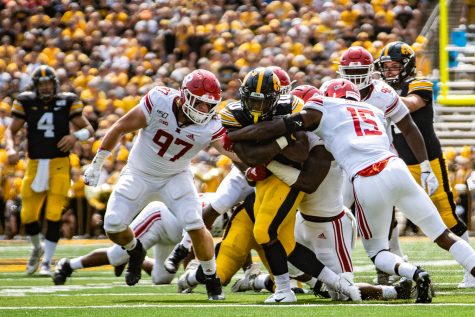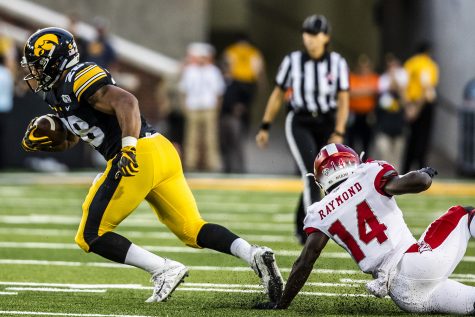September 12, 2019
From individual to team
In high school, there’s often one main guy taking the carries. At Iowa, that’s not the case, and it’s something the running backs have to understand.

Iowa running back Mekhi Sargent cuts through the defense during a football game between Iowa and Rutgers at Kinnick Stadium on Saturday, September 7, 2019. The Hawkeyes defeated the Scarlet Knights, 30-0.
“Being an unselfish player should be a part of everyone’s nature, and in the running back room, I feel like we do a really good job of just helping each other learn from mistakes, competing with one another and going out there and playing our best game,” Sargent said.
Young’s been in the system for his entire collegiate career. But with Sargent transferring in from Iowa Western and being thrown into a three-man rotation in 2018 next to Young and Ivory Kelly-Martin, he stepped up and earned himself a spot on the two-deep depth chart.
Despite the changes in mentality from high school to Iowa — with a potential community-college stop in between — Iowa’s running back production on both the running and receiving sides has been key to beginning the season 2-0.
“It’s definitely different. You go to high school and you got your guy pretty much,” Young said. “But we gel really well as a group, we work hard, we compete, we push each other. It’s real fun to be part of a group like that because you see different guys getting in there and doing different things. It’s a very fun and competitive room, we’re real close, a close-knit family.”
Iowa’s running back rotation means that, in order to succeed, the backs have to work together. Raising the team’s total yardage means raising up each running back’s yards, not just one.
“Realistically, you can’t be in every play and there’s going to be different times where you’ve got to rotate and you’re not getting in the game as much as you may want,” Young said. “That’s the thing you’ve got to understand about having a rotation in the running back room. Different guys get different looks and different reps.”
When in the game, the mindset is simple — do what you have to do to make plays.
But while on the sidelines watching teammates try and make big plays, the mindset can change. It’s easy to get into the rut of being annoyed at the playing time and the opportunities, but even watching from the side brings a chance to become better.
“[I’m] just taking mental reps, looking at the looks and the plays that they’re getting, knowing that when I go in, I could get some of the same plays, the same look,” Young said.
And when one guy has a breakout run, the running back group gets giddy.
“If one guy goes out and makes a big run, we’re pushing the next guy to make a good run,” Young said. “It’s kind of contagious. When you see a guy making a play, you want to go out there and do it. So, when you get your chance, you’re going that much harder.”

Iowa running back Toren Young breaks away from Miami (Ohio) defensive back Zedrick Raymond during their game at Kinnick Stadium on Saturday, August 31, 2019. The Hawkeyes defeated the Redhawks 38-14.
Young and Sargent’s playing styles are different. It’s easy for anyone to see when looking close enough.
“I think both guys bring a really individual skill set in some ways,” offensive coordinator Brian Ferentz said. “Young is running the ball as good as he ever has, he’s a tempo setter, and Mekhi is kind of a jack of all trades, little bit of a utility knife.”
Young is a big, physical running back, creating openings for himself where the offensive line hasn’t. Against Miami (Ohio) in Week 1, he even showed a hint of a fullback role.
“[Young’s] biggest thing might be the power back,” Daniels said. “He’s a bigger guy, so he’s going to be doing a lot of short-yardage stuff and he’s going to be trying to run over opponents.”
Sargent is smaller in height and quicker on his feet, juking around defenders and cutting in where he needs to take the ball as far as possible.
“There was a run [Sargent] converted in front of our bench; it wasn’t really clean, and somehow, he got through there,” Kirk Ferentz said. “It looked like a four-yard gain, but it was a heck of a run to make those four yards. And he’s a great young guy, just works really hard and found his rhythm.”
They run the plays that are called, whether on their feet or in their minds, and it creates an opportunity for two very different running backs to make something unique out of the same play call.
“I would say that each of us have our different approaches to the game and different plays that we like to run, but when your number is called, you have to go out there and be a playmaker and make the most of the opportunity,” Sargent said.